Strategic Management Assignment: Strategic Leadership Practices In Apple
Question
Task:
Scenario:
The Covid-19 pandemic has caused tremendous disruption in lives and in business, and the human resources function is the key to catalyzing changes in the workplace. In wake of the Covid-19 pandemic, the top management in your organisation has decided to implement a one-year work-from-home policy. Given the fact that there will be no employees physically present in the organisation, this policy change will have an impact on different HRM practices within your organisation. You are the Vice President – Human Resources and you need to write a report on how the organisation will handle this change and its impact on different HRM activities. You can choose your own organization or another other organisation of your choice for writing this report. Your strategic management assignment report must be based in the following format:
1. Executive Summary
2. Provide a brief introduction of the organisation and critically analyse the role of different HR functions in enabling your organisation to achieve its strategic objectives while reviewing staffing, development and compensation practices in detail.
3. Critically discuss and analyse the effect of Strategic HRM towards contribution and impact of HRM activities on organisational performance and development.
4. Evaluate any TWO leadership theories and discuss their application in context of your organisation. Also, propose the best/most suited leadership style for your chosen organisational development.
5. Critically analyse the factors driving change and apply any TWO change management models to your organisation, and strategies to overcome resistance. Develop a change management implementation plan along with a communication plan to address the new work-from-home policy.
6. Provide overall recommendations and final conclusion to be given for the chosen organisation.
Answer
1. Executive Summary
The strategic management assignment report has aimed at analysing how Apple can handle the new policy change of work-from-home during the ongoing pandemic and the impact on its various HRM activities. In this regard, the report has first provided an overview of the organization along with different HR functions. Furthermore, it has analysed the effect of strategic HRM and other HR activities on organizational performance and development. The report has also evaluated two leadership theories of transformational and democratic leadership, analysed two change models of Kurt Lewin and ADKAR model and provided a change implementation plan with communication plan. Lastly, it suggested the use of democratic leadership strategy in the company.
2. Background
2.1 Company Introduction
Apple is one of the most popular multinational technology companies founded in 1976 by Steve Jobs, Ronald Wayne and Steve Wozniak. The company was incorporated in 1977 when it was one of the early manufacturers producing personal computing devices along with graphical user interface. Over the multiple years of operations, it has ventured into other consumer electronics segments such as digital music players, mobile devices, wearables and notebooks (Business Standard, 2021). Apple also offers various software packages, services, accessories and networking solutions to the customers. These have been possible because the brand remains at the forefront of innovation.
2.2 Role of HR Functions
It is essential for firms to ensure efficiency in human resources department for providing the structure and ability needed to meet organizational goals and objectives alongside managing the most valuable resources, the employees. Various functions are carried out in the HR department including recruitment, selection, training and development, workplace safety, employee relations, labour laws and compensation planning (Mehra, 2018). These functions are also performed in the company of Apple in an efficient manner that has enabled it to emerge as one of the successful multinational technological companies in the world.
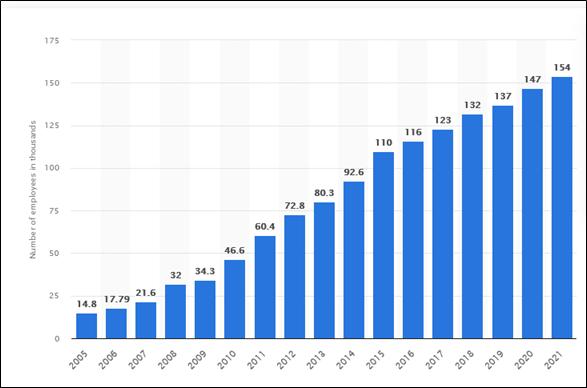
Fig 1: Apple's number of employees in the fiscal years 2005 to 2021 (in 1,000s)
(Source: Vailshery, 2021)
From the above graph, it is evident that the number of employees in Apple has grown significantly in the past 15 years. As of fiscal year 2020, the total number of employees working across different branches reached 147 thousand. While Apple is not one of the largest companies in the world in terms of staff, it is still the highest amongst all leading technology companies in terms of revenue per employee (Vailshery, 2021). This shows that the company effectively performs the different functions of recruiting, training, developing, compensating and providing benefits to the employees, making it one of the most valuable brands. The company focuses on various strategies in its HR department for efficiently managing the employees to achieve its strategic objectives (Apple, 2018). Apple ensures attracting diverse talent, posting neutral jobs, not asking for pay history and conducting return to work programmes for its employees under recruitment and hiring. Furthermore, it also emphasizes on employee growth and development by arranging training for managers, developing women leaders, offering mentorship opportunities and supporting unbiased succession planning in the organization (Apple, 2018). In addition, it provides various employee benefits including bonuses, healthcare programmes, financial support for child education, adoption assistance, employee assistance and paid leaves for parents.
3. Critical Analysis: Effect of SHRM & HRM
3.1 Strategic HRM on Contribution
Strategic HRM has gained popularity in the recent years because its positive contribution towards organizational excellence and organizational performance. In this regard, Apple also emphasizes on this approach for ensuring efficient management and utilization of its human resources (Al-Jedaiah and Albdareen, 2020). The company constantly manages its human resource policies and strategies for ensuring the right number of people present in the organization while displaying appropriate behaviours, required competencies and necessary level of motivation. An integrated approach is undertaken here for managing various HR functions in Apple including recruitment, selection, training, development and rewards that help the people and processes in acquiring desired goals. In this regard, strategic HRM has contributed positively in various areas of the technology company (Al-Jedaiah and Albdareen, 2020). It has helped in the accomplishment of goals and survival of the brand despite intense competition by supporting and implementing business strategies.
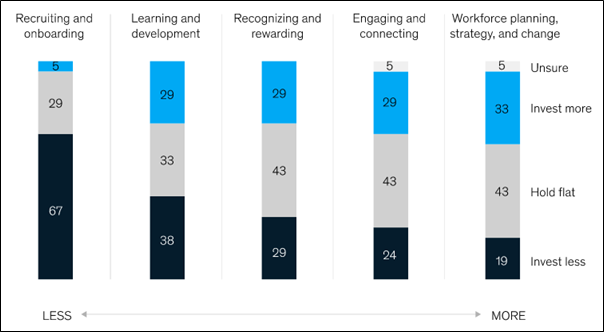
Fig 2: Expected HR activity investment in next 12 months
(Source: Hancock and Schaninger, 2020)
Furthermore, Apple has been able to gain competitive advantage in the market through efficient management of its people and HR processes, which has consequently improved the innovation potential and responsiveness of the company (Cania, 2014). This has made it easier for the company to increase its different strategic options for responding to external changes by constantly innovating its products and services. Besides, strategic HRM has also contributed towards implementing necessary strategic change in Apple as and when required and helped in enhancing the skill base of the organization. This has enabled the firm to compete with others in the industry and continue to be the most valuable brand across the world (Cania, 2014). It has been possible because strategic HRM has facilitated the development of an efficient human capital in the organization capable of meeting objectives of competitive business strategy. Thus, it can be said that SHRM has major contributions in the development of human resources in Apple, leading to its worldwide success. However, despite these SHRM approach undertaken in the company, Apple has been facing HR issues in the recent years. Hundreds of current and former employees of the organization have been complaining about their work environment in this year leading to employee unrest (Nicas and Browning, 2021). Some of the major issues identified by the employees include accounts of sexual harassment, verbal abuse, retaliation and discrimination at work alongside pay equity concerns and political matters like Texas restrictive abortion law. It has been pointed out that these HR issues are indicative of a negative workplace culture. This has affected the diversity and inclusion efforts at Apple (Schiffer, 2021). It has been further reported the culture of secrecy present in Apple associated with product information has also contributed towards the issues. Besides, some of the employees of Apple also feel that their mental health issues are generated from the hostile work environment present in the organization (Ehrenkranz, 2016). They have opined about how their concerns related to human resources or managers are often met with silence or retaliation. Thus, despite the presence of strategic HRM, this approach has not bene able to create a positive workplace culture in Apple.
3.2 HRM Activities on Organizational Performance and Development
The HR department of any organization is responsible for managing the most valuable resources or employees for achieving its strategic goals and objectives. These human resource activities are related talent management, performance management, organizational culture and others contributing towards improved organizational performance and development (Singh, Shrivastav and Munjal, 2021). Apple undertakes various HRM strategies for managing its employees and enhancing their performance to gain organizational competitiveness. These include attracting, maintaining, developing and retaining talent and high-quality personnel, making jobs interesting to the employees, ensuring their learning and development, talent management, working environment, rewarding and managing intellectual capital. In this regard, the brand undertakes strategies for enhancing inclusion and diversity, hiring practices with highest standards, pay equity, supporting careers and working towards racial equity and justice (Apple, 2021). It also arranges various training and growth or development programmes for managers and employees.
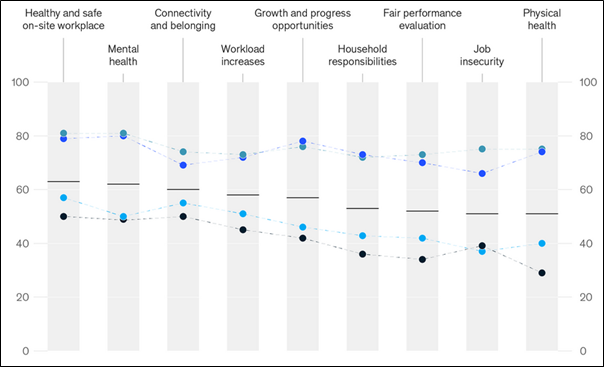
Fig 3: Challenges during COVID-19
(Source: Ellingrud, et al., 2020)
However, the company’s workplace environment and culture has been receiving criticisms from the employees because of various HR related issues. It has further been observed that with the outbreak of the COVID-19 pandemic across the entire world, diverse group of employees have been affected most severely with different challenges (Ellingrud, et al., 2020). These include issues related to healthy and safe on-site environment, connectivity and belongingness, mental health, growth and career opportunities, job insecurity, fair performance evaluation, household responsibilities and physical health. In this regard, women are experiencing disproportionate stress, LGBTQ+ employees have the fear of isolation and losing their ground at work, people of colour are fearful of work safety and career prospects and others. Thus, Apple has also been undergoing these challenges despite ensuring effective HR practices in its organization.
4. Leadership Practices
4.1 Evaluation and Application of Leadership Theories
4.1.1 Transformational Leadership
Transformational leadership theory is one of the most essential styles that is undertaken in organizations for looking after the employees being the most valuable resources. This leadership theory focuses on meeting the basic needs and satisfying higher desires of the employees by motivating them through offering newer solutions and creating a positive workplace environment (Ghasabeh, Soosay and Reaiche, 2015). Transformational leaders generally display charismatic behaviours for influencing their followers and encouraging them to provide better outcomes. They help in generating feelings of admiration, trust, respect and appreciation amongst employees through its four dimensions of idealized influence, intellectual stimulation, individualised consideration and inspirational motivation. It has been observed that transformational leadership is positively correlated with enhanced productivity and performance in the organizations (Lee, 2014). It also helps in improving organizational innovation, increasing job satisfaction and staff retention, which can be beneficial for Apple in creating a positive workplace culture.
Furthermore, this leadership approach emphasizes on organizational vision by aligning collective interests of employees with that of the leader. This can enable the company in instilling a sense of identity, purpose and belongingness amongst its employees (Lee, 2014). Besides, transformational leadership in Apple can also be beneficial in initiating change. This is by undertaking ways of encouraging employees to develop themselves, inducing them to work beyond self-interests and enhancing their awareness about various issues present in the company. Moreover, there are some basic behaviours in transformational leaders that help in contributing towards better employee management and improved organizational performance (Bottomley, Burgess and Fox III, 2014). These include vision-builder, standard-bearer, integrator and developer. Transformational leaders can manifest vision in the employees for achieving goals, initiating actions or encouraging others. They develop ethical standards and ensure proper execution of ethical behaviours amongst the employees. These leaders also inspire change through overcoming resistance and create positive work environments (Bottomley, Burgess and Fox III, 2014). Thus, it indicates that transformational leadership theory can be undertaken in the organization.
However, there are various limitations of transformation leadership approach. For example, this theory is more leader-centric and fails to account the role of followers in the entire leadership process (Andersen, 2015). It neglects the effects that leaders have on the groups and organizational performance by focusing only the effects that they generate on individual followers. Furthermore, there is lack of clarity about how leaders can create mutual trust and cooperation, collective identification, learning and efficacy and empowerment of the followers. One of the most significant negative effects that transformational leadership can create in Apple is excessive dependency of employees, thereby hampering their individual creativity (Mhatre and Riggio, 2014). The tendency of these leaders to censor critical and non-conformal viewpoints of the followers might limit innovativeness in the organization. Besides, this idealised form of considering leaders as flawless, perfect and heroes is harmful as these leaders can also fail to achieve their objectives or possess harmful behaviours (Eisenbeiß and Boerner, 2013). The inability of this approach in considering such negative aspects of human behaviour might be problematic for followers who blindly depend on them.
4.1.2 Democratic Leadership
This is another leadership approach that focuses more on people and interaction amongst themselves within a group. Democratic leaders emphasize on sharing their leadership functions with the group members by considering themselves part of the team instead of some hero figure. Some of the general traits that these leaders display include helpfulness, encouragement of participation and friendliness towards the employees (Fiaz, Su and Saqib, 2017). Apple can undertake democratic leadership strategy in its organization by fostering benevolent leaders, encouraging participation in decision making process and believing in people to carry out their own responsibilities. This can be beneficial in increasing employee productivity, job satisfaction, commitment and involvement in the organization. Furthermore, Apple needs to apply this democratic leadership for creating strong spirit and motivation amongst organizational members during the current crisis of the pandemic (Allafchi, 2017). This can help in increasing satisfaction of the employees with their jobs and professions as these leaders encourage them to participate in decision-making process and generate direct influence on customer purchases. Various behavioural styles are displayed in this leadership that can be useful for the organization. Democratic leaders consult with subordinates and employees working at the forefront and closely with customers before undertaking any decisions (Allafchi, 2017). They use minimal command and let the subordinates take accountability of their own work. The differences in opinions are valued and respected for suggestions, which further enhances employees’ sense of belongingness and responsibility in the organization. Besides, the organizational performance of Apple can be further improved with the application of democratic leadership style. The liberty of participating in decision-making process enhances the sense of responsibility amongst employees, thereby motivating them to perform better in the organization (Al Khajeh, 2018). They get the opportunity of expressing and implementing their creative ideas and differences of opinions improve the decision-making process, thus leading to improved performance.
However, there exist certain limitations as well in democratic leadership that Apple might face while undertaking it. Democratic leadership is a time-consuming process as the decision-making involves participation of all organizational members and listening to their opinions (Khan, et al., 2015). This often becomes difficult for the leader in critical situations where quick decisions are required to be performed. This leadership approach is largely dependent upon the skills and expertise of the employees. Thus, any employee with lack of knowledge or experience might delay the entire decision-making process and failure of the leadership approach (Khan, et al., 2015). Often endless discussions regarding a single topic might becoming boring for the group members. Besides, optimal solutions might also become difficult to be identified. Besides, democratic leadership allows differences in opinions and expression of individual viewpoints. Such differences might cause conflicts amongst the group members, which can lead to a negative work environment (Terzi and Derin, 2016). It would further make it difficult for the leader and the team in achieving desired organizational objectives. Negative work environment can be harmful for Apple because the mental health of the members would be affected and lead to their decreased performance.
4.2 Best Suited Leadership
An appropriate leadership theory is essential for Apple to operate in the coming months where employees are required to work remotely with the ongoing pandemic. The managers and top executives of the company must display effective leadership skills to ensure clear communication, motivation, increased employee satisfaction and engagement, which would further improve the organizational performance. In this regard, leadership skills are the most important apart from technical and management skills and strategic and business skills.
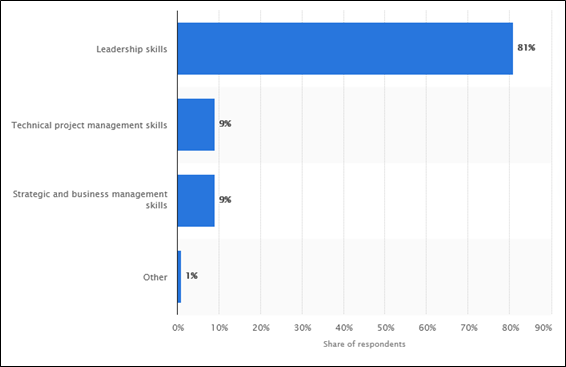
Fig 4: Most important skills to successfully manage highly complex projects in organizations worldwide as of July 2013
(Source: Statista, 2013)
Apple has been facing employee unrest because of various HR issues occurring in the company in this year. This has made it essential for the company to undertake an effective leadership approach. In this regard, democratic leadership theory will be more beneficial for the organization. This theory focuses on employees and their concerns, which is required in Apple for dealing with its current issues. It can help in resolving various issues that employees are facing including harassment, retaliation, hostile work environment and others. With the help of democratic leadership, the concerns of the employees can be met alongside motivating them to participate in decision-making process and become more accountable for improving their situation in the company. Thus, it can said that this leadership theory would be more appropriate for Apple in taking care of its human resources.
5. Change Management and Communication
5.1 Factors Driving Change
With the outbreak of the COVID-19 pandemic, there have been various social, economic, financial and political consequences for the nations and their businesses, forcing the firms to adapt themselves to this uncertain environment. While the pandemic is the dominant factor forcing the company to change, various other drivers include market crash and recession, systematic mistrust, weak productivity, talent shortage, environment concerns and technological advancements (Panetta, 2020). Various factors such as social distancing norms, lockdown and travel restrictions, fluctuating demands, consumer purchase patterns, their tastes and preferences, affordability and reduced income, disruption in global supply chains, rise in digital technologies and others have been driving change in the multinational companies like Apple.
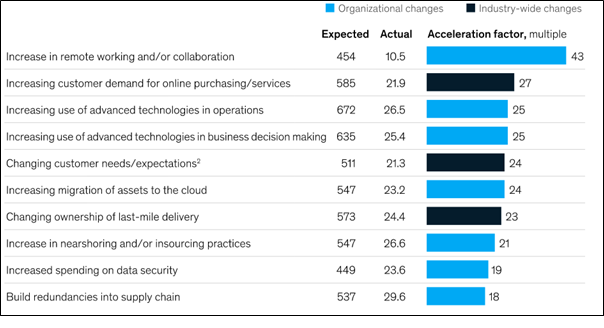
Fig 5: Required organizational and industry-wide changes
(Source: McKinsey & Company, 2020)
5.2 Change Management Models and Strategies for Resistance
5.2.1 Lewin’s Change Model
Apple can use the change model of Kurt Lewin consisting of three steps, namely, unfreezing, change process and refreezing. In the first step of unfreezing, the company needs to identify different human behaviours for analysing the mindset, mental capability and physical capacity of the organizational members (Bartunek and Woodman, 2015). This analysis must be undertaken with respect to the required change in the organization. It is essential for the change agents of Apple to agitate the equilibrium status in the company for instigating behaviours in employees that will open them towards the change process. Here, the company can cause an emotional stirring up in the employees and other members for disturbing the current group dynamics related with self-righteousness in the group members. The three most important tasks to be performed in this first stage are determining the things to be changed, ensuring support from top management and creating an initial need for change (Bamberg and Schulte, 2018). The second stage involves the actual change process where Apple needs to implement the change after unfreezing the status quo in the previous step. In this regard, the company should execute a well-planned change process for aiming towards achieving the desired objectives.
A variety of change options must be developed in this plan for undertaking the trial-and-error process to identify what works and what does not work for the company. In this stage, Apple must ensure the long-term effectiveness of the change implementation plan through two elements, namely, information flow and efficient leadership (Rosenbaum, More and Steane, 2018). Information should be shared across multiple hierarchical levels in the organization while appropriate leadership approach needs to be considered for the change process. Thus, the different tasks that the change agents of Apple should perform in this stage of change process are communicating widely and clearly, promoting and empowering action and involving others in the process. The third or final stage involves refreezing, which is sustaining the change in Apple that has been implemented. Here, the change agents and managers must focus on communicating and convincing organizational members about the new status-quo from the change implementation so that no resistance is present from individuals or groups. In this regard, all the activities, process, strategies and norms of the groups would have to be changed as per the new status (Bartunek and Woodman, 2015). Thus, the company should focus on inducing these new changes into the workplace culture, develop and promote various ways for sustaining the change in long-term, offer required support and training and communication to the staff.
5.2.2 ADKAR Change Management Model
Apple can also consider the ADKAR model of change management in its organization. It is a more outcome-oriented change approach that focuses on reducing resistance to change from employees and other organizational members. The five steps involved in this change management model are awareness, desire, knowledge, ability and reinforcement (Ali, et al., 2021). The first two steps of awareness and desire falls in the current stage of the company where change is required but has not yet started. Here, both the managers and leaders should focus on creating awareness amongst the members about the need for a change in the current situation. It has already been observed that Apple is facing various issues related to its workplace culture and human resources. It is the responsibility of the managers here to initiate the change. Furthermore, in the second step, they must focus on fostering the need for change through showing support, guidance and connecting with the different stakeholders expected to get affected by the change (Houben, et al., 2020). In this step of fostering desire, the managers can come across resistance to change and accordingly, they should emphasize on identifying the reasons behind such resistance.
The second stage involves transition from the current to the future stage. In this transition period, two steps are involved, namely, knowledge and ability. The change managers and agents of Apple should focus on providing detailed knowledge about how the change will be undertaken in the company (Shah, 2014). In this regard, they must focus on the responsibilities, tools, process and skills required for the change process and communicate them to the employees. The managers in this transition stage should also ensure that all employees involved in the process are capable of making the change. The gap between the knowledge and ability of the employees must be reduced here with support, training and education. Besides, task change leaders are responsible here for gathering valuable feedback from their teams, identifying potential issues and developing strategies for reducing them (Teczke, Sansyzbayevna Bespayeva and Olzhabayevna Bugubayeva, 2017). The last stage is the future where the company should focus on reinforcement. The managers and leaders of Apple must make sure that employees diligently follow the new processes, strategies and activities for its long-term sustainability. In this regard, they can appreciate and celebrate the successful implementation of the changed process to ensure reinforcement.
5.2.3 Strategies for Overcoming Resistance
Apple can consider various strategies for overcoming resistance to change in the organization. It can ensure proper communication and education of the organizational members including employees to reduce their fear of unknown, job insecurity and changed practices. Furthermore, the second strategy can be enhancing participation of employees and managers from all hierarchical levels by undertaking their suggestions and eliminating their concerns (Hon, Bloom and Crant, 2014). The third strategy can be providing proper guidance and support to the employees by increasing emotional intelligence of managers so that they can connect with their people. The company can also offer incentives to the employees by drawing agreements. In addition, it can resort to co-opting and coercion strategies as the last options for overcoming resistance to change.
5.3 Change Management Implementation Plan
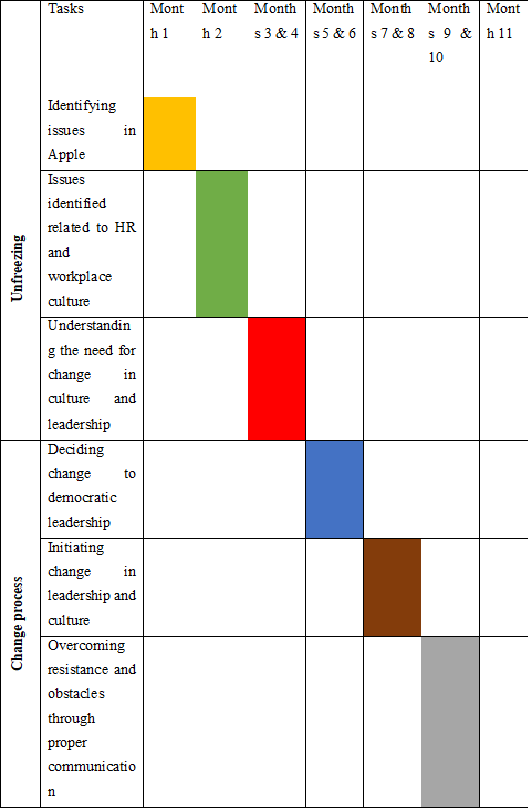
5.4 Communication Plan
|
Audience |
Key Messages |
Delivery methods |
Duration |
Location |
|
Employees |
The company has decided to introduce remote working/ work-from-home policy for all in the coming twelve months |
Memo, emails |
One to two weeks prior to implementation |
In all office premises |
|
Managers |
All employees and managers will undergo remote working |
Emails and meetings |
Three weeks prior to implementation |
Office premises |
|
Customers |
No retail outlets will be opened, services and products will be offered online |
Emails, video upload, website marketing, blogs |
One week prior to implementation |
Online over digital accounts |
|
Suppliers |
Remote collaboration with suppliers |
Emails, video conferencing, memos |
Two weeks prior to implementation |
Digital accounts, all suppliers’ location across the world |
6. Recommendations and Conclusion
As per the above analysis on strategic management assignment, it is stated that Apple should foster a positive workplace environment with an efficient culture that ensures inclusion and diversity. It should focus on resolving the persistent issues related to human resources and hostile environment in the organization. Furthermore, for implementing work-from-home policy in the company for the upcoming months, Apple should consider a democratic leadership strategy by focusing on both people and effective decision-making. The report analysed key strategic HRM activities and strategies in the organization by focusing on different activities, leadership approaches, change management models and developing both change implementation and communication plans. With this report, it will be easier for the company to focus better on its human resources.
7. Reference List
Al Khajeh, E.H., 2018. Impact of leadership styles on organizational performance. Journal of Human Resources Management Research, 2018, pp.1-10.
Ali, M.A., Zafar, U., Mahmood, A. and Nazim, M., 2021. The power of ADKAR change model in innovative technology acceptance under the moderating effect of culture and open innovation. LogForum, 17(4).
Al-Jedaiah, M.N. and Albdareen, R., 2020. The effect of strategic human resources management (SHRM) on organizational excellence. Strategic management assignment Problems and Perspectives in Management, 18(4), p.49.
Allafchi, N., 2017. Effect of democratic leadership style on management of communication with customers in Melli Banks of Hamedan. Uluslararas? Kültürel ve Sosyal Ara?t?rmalar Dergisi (UKSAD), 3(2), pp.168-179.
Andersen, J.A., 2015. Barking up the wrong tree. On the fallacies of the transformational leadership theory. Leadership & Organization Development Journal, 36(6), pp. 765-777.
Apple, 2018. Apple UK Gender Pay Gap Report 2017–2018. [pdf] Available at: < https://www.apple.com/legal/more-resources/docs/uk-gender-pay-gap-report-2018.pdf > (Accessed 23 December 2021)
Apple, 2021. Inclusion & Diversity. [online] Available at: < https://www.apple.com/diversity/ > (Accessed 23 December 2021)
Bamberg, S. and Schulte, M., 2018. Processes of change. Environmental psychology: An introduction, pp.307-318.
Bartunek, J.M. and Woodman, R.W., 2015. Beyond Lewin: Toward a temporal approximation of organization development and change. Annu. Rev. Organ. Psychol. Organ. Behav., 2(1), pp.157-182.
Bottomley, K., Burgess, S. and Fox III, M., 2014. Are the behaviors of transformational leaders impacting organizations? A study of transformational leadership. International Management Review, 10(1), pp.5-9.
Business Standard, 2021. What Is Apple Inc? [online] Available at: < https://www.business-standard.com/about/what-is-apple-inc > (Accessed 23 December 2021)
Cania, L., 2014. The impact of strategic human resource management on organizational performance. Economia. Seria Management, 17(2), pp.373-383.
Ehrenkranz, M., 2016. Apple employees say their mental health issues came from alleged hostile work environment. [online] Available at: < https://www.business-humanrights.org/en/latest-news/apple-employees-say-their-mental-health-issues-came-from-alleged-hostile-work-environment/ > (Accessed 23 December 2021)
Eisenbeiß, S.A. and Boerner, S., 2013. A double?edged sword: Transformational leadership and individual creativity. British Journal of Management, 24(1), pp.54-68.
Ellingrud, K., Krishnan, M., Krivkovich, A., Kukla, K., Mendy, A., Robinson, N., Sancier-Sultan, S. and Yee, L., 2020. Diverse employees are struggling the most during COVID-19—here’s how companies can respond. [online] McKinsey & Company. Available at: < https://www.mckinsey.com/featured-insights/diversity-and-inclusion/diverse-employees-are-struggling-the-most-during-covid-19-heres-how-companies-can-respond > (Accessed 23 December 2021) Fiaz, M., Su, Q. and Saqib, A., 2017. Leadership styles and employees' motivation: Perspective from an emerging economy. The Journal of Developing Areas, 51(4), pp.143-156.
Ghasabeh, M.S., Soosay, C. and Reaiche, C., 2015. The emerging role of transformational leadership. The Journal of Developing Areas, 49(6), pp.459-467.
Hancock, B. and Schaninger, B., 2020. HR says talent is crucial for performance—and the pandemic proves it. [online] McKinsey & Company. Available at: < https://www.mckinsey.com/business-functions/people-and-organizational-performance/our-insights/hr-says-talent-is-crucial-for-performance-and-the-pandemic-proves-it > (Accessed 23 December 2021) Hon, A.H., Bloom, M. and Crant, J.M., 2014. Overcoming resistance to change and enhancing creative performance. Journal of Management, 40(3), pp.919-941.
Houben, M.A.M., Caekebeke, N., van den Hoogen, A., Ringenier, M., Tobias, T.J., Jonquiere, F.J., Sleeckx, N., Velkers, F.C., Stegeman, J.A., Dewulf, J. and Postma, M., 2020. The ADKAR® change management model for farmer profiling with regard to antimicrobial stewardship in livestock production. Vlaams Diergeneeskundig Tijdschrift, 89(6), pp.309-314. Khan, M.S., Khan, I., Qureshi, Q.A., Ismail, H.M., Rauf, H., Latif, A. and Tahir, M., 2015. The styles of leadership: A critical review. Public Policy and Administration Research, 5(3), pp.87-92. Lee, M., 2014. Transformational leadership: is it time for a recall?. International journal of management and applied research, 1(1), pp.17-29.
McKinsey & Company, 2020. How COVID-19 has pushed companies over the technology tipping point—and transformed business forever. [online] Available at: < https://www.mckinsey.com/business-functions/strategy-and-corporate-finance/our-insights/how-covid-19-has-pushed-companies-over-the-technology-tipping-point-and-transformed-business-forever > (Accessed 23 December 2021) Mehra, M.R., 2018. Human Resource management and its importance for today’s organizations. Journal of HR, Organizational Behaviour & Entrepreneurship Development, 2(2), pp.15-20.
Mhatre, K.H. and Riggio, R.E., 2014. Charismatic and transformational leadership: Past, present, and future. The Oxford handbook of leadership and organizations, pp.221-240.
Nicas, J. and Browning, K., 2021. Tim Cook Faces Surprising Employee Unrest at Apple. [online] The New York Times. Available at: < https://www.nytimes.com/2021/09/17/technology/apple-employee-unrest.html > (Accessed 23 December 2021) Panetta, K., 2020. 7 Macro Factors That Will Shape the 2020s. [online] Gartner. Available at: < https://www.gartner.com/smarterwithgartner/8-macro-factors-that-will-shape-the-2020s > (Accessed 23 December 2021)
Rosenbaum, D., More, E. and Steane, P., 2018. Planned organisational change management: Forward to the past? An exploratory literature review. Journal of Organizational Change Management, 31(2), pp. 286-303. Schiffer, Z., 2021. Apple employees are going public about workplace issues — and there’s no going back. [online] The Verge. Available at: < https://www.theverge.com/2021/5/25/22453302/apple-culture-secrecy-leak-antonio-garcia-martinez-letter > (Accessed 23 December 2021) Shah, M.H., 2014. An Application of ADKAR Change Model for the Change Management Competencies of School Heads in Pakistan. Journal of Managerial Sciences, 8(1).
Singh, A.K., Shrivastav, P. and Munjal, N., 2021. The Impact of Strategic Human Resource Management practices on Global competitiveness. European Journal of Molecular & Clinical Medicine, 8(1), pp.2166-2172. Statista, 2013. Most important skills for managing complex projects in organizations worldwide 2013. [online] Available at: < https://www.statista.com/statistics/293406/most-important-skills-for-managing-complex-projects-in-organizations-worldwide/ > (Accessed 23 December 2021)
Teczke, M., Sansyzbayevna Bespayeva, R. and Olzhabayevna Bugubayeva, R., 2017. Approaches and models for change management. Jagiellonian Journal of Management, 3(3).
Terzi, A.R. and Derin, R., 2016. Relation between Democratic Leadership and Organizational Cynicism. Strategic management assignment Journal of Education and Learning, 5(3), pp.193-204.
Vailshery, L.S., 2021. Apple employee number 2005-2021. [online] Statista. Available at: < https://www.statista.com/statistics/273439/number-of-employees-of-apple-since-2005/ > (Accessed 23 December 2021)












